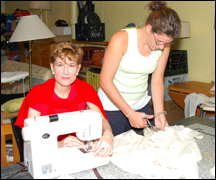
Americans dont know how to dress, says Linda Przybyszewski, associate professor of history at the University of Notre Dametheir clothing is too tight, too big, or inappropriate for the occasion.
The title of her book-in-progress is a little more blunt:Nation of Slobs: How Americans Learnedand ForgotHow to Dress.
A colleague suggested she called the bookWhat Not to Wear,she says,But that was already taken,by the popular cable TV makeover show.
But Przybyszewski (pronounced preh-beh-SHEV-ski) does have a lot in common with style gurus Stacy London and Clinton Kellyshe goes through life wishing she could make over other peoples ill-fitting outfits.
The book is a bit of a departure for Przybyszewski, a legal scholar whose previous books include a biography of Supreme Court Justice John Marshall Harlan, lone dissenter in Plessy v. Ferguson (1896), which upheld Southern segregation statutes.
But Przybyszewski has sewn since she was a little girl and still makes most of her own clothes (I dont make sweaters, and I cant cobble shoes,she clarifies). Something resonated when she came across a 1950s home economics textbook,Clothes for You,by Mildred Graves Ryan and Velma Phillipsthe dress doctors,she calls them.
Ryan and Phillipsbook taught young girls both the art of dressing and the art of lifesewing, design and color theory, grooming, budgeting. Theyre skills girls have missed out on since the disappearance of home economics from school curriculums in the 1970s, Przybyszewski says.
The textbook inspired both her own new book and the University Seminar shell teach this fall,Fashioning the Self: Identity, Aesthetics, Economics and the Clothing of the Human Form.
Students today live on the other side of two dress revolutions, Przybyszewski notesthe 1920s, when women rebelled against the painful corsets and hourglass figures of the 19th century, and the 1960s, when informality in dress became the norm,and everything fell apart.
There used to be a difference between city and country dress, and between day and evening dress, she notes. People used to dress up for church and for funerals. Employers today have to cope with young employees who cant distinguish between appropriate attire for the beach and for the office.
In exploring the rules of the art of dress from previous eras, Przybyszewski realized that you have to have your clothing tailored, or make it yourself, to apply the rulesyou wont find the right color, the right fabric, the right fit in off-the-rack merchandise.
Dressmakers feel sorry for people who dont sew,she says.Most people are dependent on ready-to-wear sizingthey dont realize their clothing could be made to fit.
This summer, Przybyszewski and niece Ursula Adams were busy sewing muslin copies of womens dresses and loungewear from different fashion eras for her upcoming class.
Her students will likely be easy to spot on campus this fall. One assignment will be to dress in typical 1950s-style student dresstweed jackets and ties, poodle skirts and twinsets with sensible oxfords and the likeand report back on the reactions they get.
The classand the bookwill be a lot of fun, Przybyszewski adds.
Ive sewn my whole life and loved it,she says.Ive learned a lot. I never thought I would be using two very different parts of myselfsewing, and history and research.
And for those who would like to have better-fitting clothes, she does have a tip: Think separates.
Buy for the hipsits easy to fix the waist,she says.You can take things in, but theres no room in the fabric to let things out. If you cant do alterations yourself, find a tailor.
Sewing is not that hard to learn, she adds.People think its hard to sew, but theyll spend hours miserable in the mall looking for something to wear.
Contact: Linda Przybyszewski, 574-631-7661, Przybyszewski.1@nd.edu
p.
TopicID: 29206